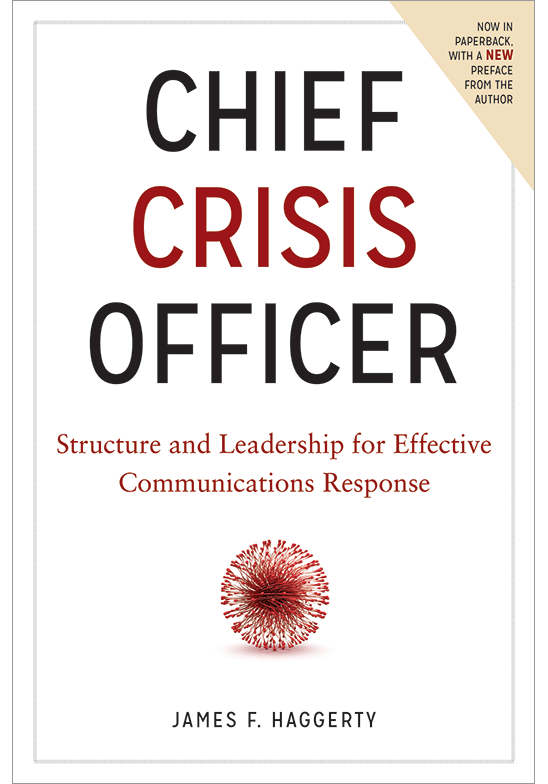‘Chief Crisis Officer’: Responding Effectively to the Crisis Elements of Litigation

This is an excerpt from CrisisResponsePro founder James F. Haggerty’s new book, Chief Crisis Officer: Structure and Leadership for Effective Communications Response (ABA Publishing). We will post other excerpts to the Knowledge Exchange periodically. In this section, Haggerty discusses tresponding to the crisis elements of litigation.
What are the key elements and strategies surrounding litigation communications that crisis communicators should know to allow them to respond effectively during this particular subset of crisis issue?
A few general guidelines follow:
- Understand the unfolding nature of litigation. If you are a defendant company or organization, you’re at a natural disadvantage when facing off against plaintiffs’ lawyers or prosecutors, because they can usually trot out a sympathetic victim in front of the cameras, or in press releases and other filings, to show the wrong you’ve done. For example, in the case of a product liability lawsuit, the injured party might be wheeled out in a wheelchair for a press conference or sit down for a tearful one-on-one with 60 Minutes or one of the morning news programs. In a criminal prosecution, the prosecutor might put forth a presentation of “facts” at a press conference when they file an indictment, attempting to frame the issues out of the gate: Specifically, they want to impart to the public that you or your company are outlaws, and they are the white hat riding into town to clean up Dodge.
The best way to counteract such attacks is to meet the enemy on the battlefield: Frame the issues with key media outlets before they sit down for that teary interview or attend the incendiary press conference. This is hard to do during the initial phases of a lawsuit, when there’s a complaint and not much else, but it can be done. Particularly in litigation, remember the following: The other side may get the first bite of the apple . . . but it’s a big apple. There will be plenty of opportunities to fight back, given the unfolding nature of litigation itself.
During a lawsuit, there will be many events and opportunities to fight, such as the filing of an answer, a motion to dismiss, the discovery process (which goes on for months or years and tends to involve dozens of individuals court filings), a motion for summary judgment, trial (if there is a trial), and appeals. Although the complaint is often the crisis event that catches a company or organization unaware and sets the issues in motion, opportunities exist at various points in a lawsuit to frame the issues with various stakeholders before the next filing or event occurs. The core crisis communications team and Chief Crisis Officer should be working with the legal team to figure out when and where those points of inflection exist and use them to properly frame the issues in the minds of the various stakeholders. The filing of a complaint, even with all the attendant emotion and hoopla, is just the opening inning of the ballgame.
- Create the “Mantra of the Case.” In doing the above, you’re creating what I call the “mantra” of the case: the one or two lines that explain what’s really going on in this litigation — messages that become shorthand for media and other audiences when describing the litigation as it moves forward.
Describing “what’s really going on” is key. The facts and the law that are at the heart of the story behind the case are usually buried in thousands of pages of legal documents. Deep inside those court filings are core messages that should become your mantra. Digging through those nuggets to find those key elements . . . aye, there’s the rub. If you find those nuggets and present them in a compelling fashion — using the facts and the law to tell a story rather than just a procedural play-by-play — you will begin to create a mantra of the case that is repeated over and over again during the course of this particular crisis.
- Engage Third Parties Who Are Writing the “History” of the Case. Who is telling the story? Who is writing the history of the case even as it’s going on? The Chief Crisis Officer and the core crisis communications team should be working with the lawyers to engage influential individuals across a variety of disciplines — media, the investment community, politicians, other policymakers, and so forth — who will influence the way the case is perceived now and in the future. Do they understand your story? Are they framing the issues and your side’s position in the right way? Engaging third-party commentators who are, quite frankly, telling people what to think about your legal issue can go a long way to establishing, or rewriting, the history of the case.
This is an abridged version of an article that appeared today on the CrisisResponsePro paid subscription portal. (CrisisResponsePro subscribers can access the full version by clicking here. ID and password are required.) To take advantage of all of the content, data, and collaborative resources CrisisResponsePro has to offer, contact us at info@crisisresponsepro.com.




 Back to Blog
Back to Blog